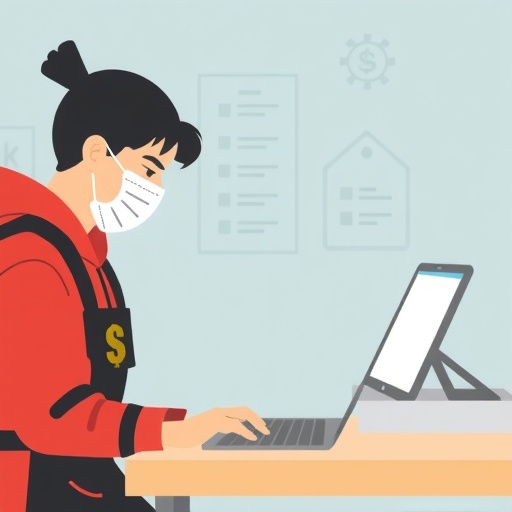In the wake of the COVID-19 pandemic, the global workforce has confronted unprecedented challenges, particularly with regard to the intersection of employment conditions and health protections. A groundbreaking study conducted in South Korea sheds light on the critical nexus between non-standard employment, the availability of paid sick leave, and the consequential financial ramifications during periods of mandated self-isolation. The research presents an intricate cross-sectional analysis, revealing profound socioeconomic vulnerabilities that have often been overlooked in traditional labor policy frameworks.
At the heart of this investigation lies the concept of non-standard employment, a designation encompassing part-time, temporary, gig, and contract work arrangements that differ fundamentally from the conventional full-time, permanent employer-employee relationship. These employment models, while offering flexibility and economic opportunities, frequently lack the protective benefits that are customary in standard contracts, such as paid sick leave. This absence became glaringly significant as the pandemic necessitated widespread self-isolation directives to curb viral transmission.
South Korea provides a compelling case study given its robust public health response juxtaposed against a labor market increasingly characterized by precarity. The study draws on extensive survey data collected during the height of the pandemic’s self-isolation mandates, analyzing how individuals within non-standard employment brackets coped with mandatory absences from work. One poignant finding is the disproportionate income loss suffered by these workers, who were less likely to receive paid sick leave compared to their full-time counterparts.
From a technical standpoint, the analysis employed multivariate regression models to isolate the impact of employment type on income loss, controlling for demographic variables such as age, gender, education, and industry sector. The models highlighted that workers in non-standard roles were statistically significantly more vulnerable to income shocks when isolated for COVID-19, underscoring systemic gaps in employment protections. The predictive validity of these models affirms that without policy intervention, such disparities are likely to worsen in future public health crises.
The implications for public health and labor economics are multifaceted. Economically, lost income not only inflicts immediate hardship on workers but also exacerbates longer-term inequality by depleting savings and increasing debt dependence. Psychologically, financial stress compounds the mental health toll imposed by pandemic conditions. This cyclical burden disproportionately afflicts those already marginalized within the labor market, amplifying inequities.
Importantly, the absence of paid sick leave in non-standard employment sectors creates a paradoxical risk environment. Without financial support, infected workers are incentivized to forgo isolation, thereby heightening community transmission risk. The research presents compelling evidence that enhancing sick leave coverage could serve as a dual-purpose public health measure—safeguarding both individual welfare and broader population health.
South Korea’s labor policies, while progressive in certain respects, have historically not mandated paid sick leave across all employment categories. This study reveals that such regulatory gaps proved costly during the pandemic, suggesting an urgent need for legislative reform. By analyzing comparative data from standard and non-standard workers, the research advocates for inclusive frameworks that mandate minimum sick leave entitlements irrespective of contract type.
Furthermore, the study engages with international discourse on labor rights and pandemic preparedness, situating its South Korean findings within global trends. The research underscores that the economic fallout from health crises is not merely a product of the pathogen itself but is deeply intertwined with social determinants and labor market structures. It challenges policymakers to rethink labor protections as integral components of health emergency responses.
Addressing these dynamics requires nuanced policy instruments that reconcile economic flexibility with social security. The study posits that innovations in social insurance schemes, such as portable benefits linked to the individual rather than the employer, could bridge gaps in current systems. Such mechanisms would ensure continuity of income support during health-related absences, irrespective of employment form.
In scrutinizing the data further, the study identifies demographic subgroups within non-standard employment that were particularly vulnerable. Young workers, women, and minority populations disproportionately occupied roles lacking paid sick leave, signaling intersectional vulnerabilities. Targeted interventions, therefore, must account for these layered dimensions of risk to effectively mitigate health and economic disparities.
From a methodological perspective, the cross-sectional design of the study offers a snapshot that captures the immediate effects of self-isolation on income loss. While longitudinal data would enrich understanding of long-term trajectories, the current findings serve as a critical evidentiary basis to inform urgent policy responses. The statistical rigour and contextual depth lend credibility to the call for systemic reform.
Looking forward, the integration of public health and labor policy must become a priority in pandemic preparedness. The study illuminates pathways for collaboration between ministries of health, labor, and social welfare to formulate cohesive strategies that protect vulnerable workers while safeguarding population health. This interdisciplinary approach represents a paradigm shift necessary to confront emerging health crises.
Moreover, technological advancements in workforce management and data analytics can enhance real-time monitoring of employment vulnerabilities during public health emergencies. Deploying AI-driven platforms to track paid sick leave access and income disruption could enable adaptive policy responses, minimizing socioeconomic fallout. The study implicitly advocates for harnessing such innovations in tandem with legislative reform.
In conclusion, this seminal research from South Korea brings to the fore the hidden economic toll borne by non-standard workers during COVID-19 self-isolation. By exposing the interplay between employment precarity, lack of paid sick leave, and income loss, it underscores urgent gaps in current policy architectures. This evidence-based analysis compels stakeholders across sectors to rethink labor protections not as peripheral employer obligations but as cornerstone elements of public health resilience. The lessons learned resonate globally, offering a blueprint for more equitable and effective pandemic response frameworks in the future.
Subject of Research: Non-standard employment, paid sick leave, and income loss during COVID-19 self-isolation in South Korea
Article Title: Non-standard employment, paid sick leave, and income loss during COVID-19 self-isolation: cross-sectional findings from South Korea
Article References:
Hwang, S. Non-standard employment, paid sick leave, and income loss during COVID-19 self-isolation: cross-sectional findings from South Korea. Int J Equity Health 24, 255 (2025). https://doi.org/10.1186/s12939-025-02636-7
Image Credits: AI Generated




